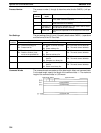
351
When the execution condition is OFF, IORD(––) is not executed. When the
execution condition is ON, IORD(––) transfers data from the specified Special
I/O Unit’s memory to words beginning at D. The source information provides the
node number of the Special I/O Unit and the number of words to be read, as
shown in the following diagram.
S:
Digits 2 to 4: Number of words to read (001 to 128)
Digit 1: Node number of the Special I/O Unit (0 to F)
The control code (C) depends on the Special I/O Unit being specified. Refer to
the Unit’s Operating Manual for details.
Example When IR 00000 goes from OFF to ON, the following instruction transfers 100
words from the memory area of Special I/O Unit number 3 to DM 0100 through
DM 0199.
IORD(––)
C
#3100
DM 0100
00000
Address Instruction Operands
00200 LD 00000
00201 @IORD(––)
C
#3100
DM 0100
Flags ER: The last three digits of S (number of words specifier) isn’t BCD or isn’t
within the range of 001 through 128.
Indirectly addressed DM word is non-existent. (Content of DM word is
not BCD, or the DM area boundary has been exceeded.)
The source Unit’s unit number isn’t 0 to F or it is mounted on a Slave
Rack.
The received data overflows a data area boundary.
EQ: ON when the data was read successfully, otherwise OFF.
5-29-2 SPECIAL I/O UNIT WRITE – IOWR(––)
C: Control code
IR, SR, AR, DM, HR, TC, LR, #
D: Destination information
IR, SR, AR, DM, HR, TC, LR, #
Operand Data Areas
S: First source word
IR, SR, AR, DM, HR, TC, LR
Ladder Symbols
IOWR(––)
C
S
D
@IOWR(––)
C
S
D
Limitations Only Special I/O Units mounted to the PC’s CPU Rack or Expansion I/O Racks
can be specified.
The last three digits of D must be BCD (from 001 to 128).
Description
Special I/O Unit Instructions Section 5-29


















